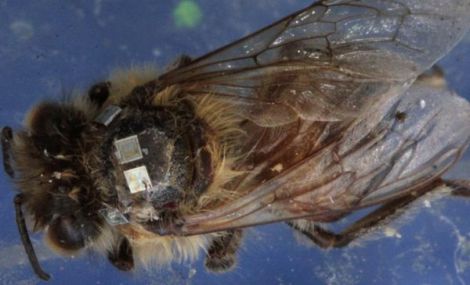
A zombee with a tracker. (Photo by Christopher Quock.)
Some of the scientists investigating the mysterious honeybee die-offs suspect zombie bees, bees that are being mind-controlled by parasitic scuttle fly maggots. Unlike human zombies, bee zombies (or, inevitably, “zombees”) do not have telltale tattered clothes or dark eye makeup. So in order to tell whether they’re dealing with bees or zombees, researchers are affixing the little guys with miniature radio trackers.
Here’s how the zombee nonsense started: Last year, while San Francisco State scientist John Hafernik was looking for dead bugs to feed insects, he discovered some maggot-infested bee carcasses under a streetlight. (Picking up dead bugs that are crawling with live bugs: just a small part of the glamorous life of a scientist.) This was odd, because bees don’t generally leave their hives at night. Hafernik got to thinking: Why were these bees behaving so out of character? Could it be that the maggots were not only infesting the poor bees, they were controlling their minds as well?
Enter crazy technology: Hafernik and colleagues are affixing tiny trackers, about the size of a piece of glitter, onto about 500 honeybees that are infested with scuttle fly larvae. The trackers register when the insects leave the hive and when they return — if they return. This will help them figure out whether the maggots are mind-controlling the bees into abandoning their hives — or, alternately, whether the bees are taking one for the team, leaving the group and letting themselves die off to prevent a larger infestation.
We would like to be the first to wish Dr. “I pick up bugs after going to school for 12 years” Hafernik best of luck in fighting these tiny, evil arthropods.



